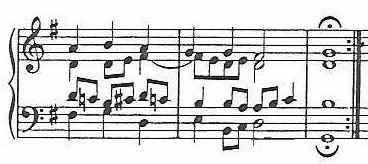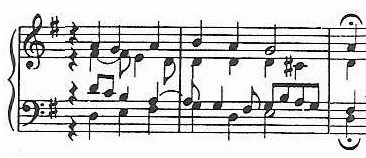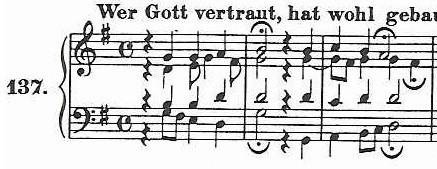 |
 |
 |
Prolongation: Basic Analysis of Chorale Harmonization (Part Two) |
| Example 222.1 |
| Example 222.2 |
| Next: Cadential Structure Analysis, Part Three Back: Part One |
| [[ - - - - I ] - - - - - V ] |
| The third phrase (example 222.2) consists of a motion into the initial structural tonic followed by a motion from that tonic to the structural dominant that concludes the phrase: a half cadence. The strong submediant returns on the second beat of this phrase, and the penultimate chord (last two beats of the second measure) somewhat resembles that submediant. |
| The fourth phrase (Example 222.3) concludes the first section of the chorale. It opens with a short motion into the initial structural tonic, which is then prolonged by way of a dominant-chord motion into our familiar submediant chord, which moves on to a first inversion of the tonic. The structural subdominant (represented here by a ii-6/5 chord) is compressed into the second half of the second beat. The structural dominant relaxes into the last two beats before resolving into the final tonic. Full cadence. |
| Example 222.3 |
| [[ - I - - - - I ] IV V I ] |
| [ [ I - I ] V] |
| [ I - (vi) - V - I ] |
| In the first phrase, the motion from the initial structural tonic to the structural dominant goes by way of a submediant so strong I am tempted to label it a structural subdominant. This chorale, and Bach's harmonization of it, later on follows up this strong submediant with what is traditionally called a modulation, but which is best heard as a prolongation of the tonic function. |
| The two phrases in Example 222.1 illustrate three different relationships between the tonic and the dominant functions. In the first phrase, the structural dominant moves to the final structural tonic in a full cadence. In the second phrase, the second chord functions as a non-structural dominant prolonging the structural tonic that opens the phrase, and the last chord is a structural dominant concluding a half cadence [I-V]. |
 |
| MODULES Cadential Structure Prolongation of Function: Basic Analysis of Chorale Harmonization (Part Two) Lester Allyson Knibbs, Ph.D. |
[I-IV-V-I] Prolongation: Back / Next Elaboration of Motion In Symphonic Composition |
Introduction The Chaconne Cadential Structure --- Unitary & Binary Structures Linear & Periodic Structures Modules and Modalities Structural Counterpoint Modular Composition Appendices |